Sizzling Philly Cheesesteak Pasta Recipe: A Comforting Twist
Crafting a mouthwatering philly cheesesteak pasta combines classic Philly sandwich flavors with comforting noodle goodness.
Steak strips and melted cheese create an irresistible fusion of textures and tastes.
Peppers and onions add a delightful crunch to every single bite.
Weeknight dinners suddenly become extraordinary with this simple yet impressive dish.
Home cooks can easily recreate restaurant-style magic in their own kitchen.
Cheesy, savory goodness awaits you in this quick and satisfying meal that promises to become a new family favorite.
Let’s dive into a recipe that transforms ordinary ingredients into something spectacular.
Philly Cheesesteak Pasta Loaded With Savory Goodness
Ingredients Included in Philly Cheesesteak Pasta
For the Protein:For the Pasta:For the Dairy:For the Vegetables:For the Seasonings and Liquids:For the Cooking Liquids:How to Prepare Philly Cheesesteak Pasta
Step 1: Boil Pasta
Grab a large pot and fill it with water. Sprinkle in some salt and bring the water to a rolling boil.
Drop in the pasta and cook until it’s perfectly tender but still has a slight bite. Drain the pasta in a colander and set it aside, ready for its cheesy destiny.
Step 2: Sizzle the Beef
Heat up a large skillet with a splash of olive oil over medium-high heat. Toss in the beef slices and let them dance in the pan.
Sear each side until they develop a beautiful golden-brown crust, which should take about 2-3 minutes. Once done, transfer the beef to a plate and keep it warm.
Step 3: Awaken the Vegetables
In the same skillet, melt some butter and add:Let these veggies soften and become translucent, stirring occasionally. Sprinkle in minced garlic, a dash of Worcestershire sauce, salt, pepper, and smoked paprika.
Stir everything together and let the aromatics bloom for about a minute.
Step 4: Create the Creamy Base
Pour in beef broth and heavy cream, stirring to combine the liquids into a smooth mixture.
Reduce the heat to medium-low and let the sauce simmer gently, allowing the flavors to meld together for around 3 minutes.
Step 5: Cheese Transformation
Gradually add:Stir continuously until the cheeses melt completely, creating a luxuriously smooth and creamy sauce that will make mouths water.
Step 6: Bring It All Together
Return the seared beef to the skillet. Add the cooked pasta and toss everything together, ensuring each piece is lavishly coated in the cheesy sauce.
Step 7: Serve and Enjoy
Transfer the pasta to serving plates. Sprinkle some extra provolone on top for an additional cheesy punch.
Serve immediately while it’s hot and incredibly tempting.
Tips to Perfect Philly Cheesesteak Pasta Dish
Variations That Refresh Philly Cheesesteak Pasta
Suggested Sides With Philly Cheesesteak Pasta
Storing Philly Cheesesteak Pasta for Later Enjoyment
Store leftovers in an airtight container for up to 3-4 days. Cool pasta completely before sealing to prevent bacterial growth.
Transfer to freezer-safe containers, removing excess air. Keeps well for 2-3 months. Avoid freezing if cream-based sauce is used.
Place portion in microwave-safe dish. Add splash of milk or broth to restore moisture. Heat in 30-second intervals, stirring between each to prevent uneven warming.
Warm in skillet over medium-low heat. Add small amount of beef broth or cream to revive sauce consistency. Stir gently to prevent pasta from breaking down, heating until steaming throughout.
FAQs
The dish combines savory beef, sweet caramelized onions, peppers, and a rich, creamy cheese sauce that mimics the classic Philly cheesesteak sandwich flavors.
Yes, you can use ribeye, sirloin, or even thinly sliced flank steak. The key is to choose a tender cut that cooks quickly and remains juicy.
No, the recipe is not spicy. It uses smoked paprika for depth of flavor, but doesn’t include any hot peppers or spicy ingredients. You can add red pepper flakes if you want heat.
Print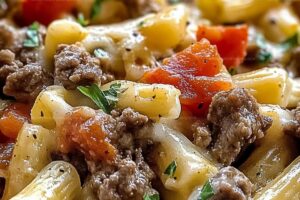
Philly Cheesesteak Pasta Recipe
- Total Time: 30 minutes
- Yield: 4 1x
Description
Creamy Philly cheesesteak pasta brings hearty Philadelphia flavors into a comforting one-pot meal. Melted cheese, tender beef, and sautéed peppers create a delicious twist on classic sandwich ingredients that anyone can enjoy.
Ingredients
Proteins:
- 1 pound (454 grams) beef sirloin or ribeye, thinly sliced
Pasta and Base:
- 12 ounces (340 grams) pasta (penne, rigatoni, or rotini)
- 1.5 cups (360 milliliters) beef broth
- 1 cup (240 milliliters) heavy cream
- 1.5 cups shredded provolone cheese
- 0.5 cup shredded mozzarella cheese
Vegetables and Seasonings:
- 1 small onion, thinly sliced
- 1 green bell pepper, sliced
- 1 red bell pepper, sliced
- 2 cloves garlic, minced
- 1 tablespoon olive oil
- 1 tablespoon unsalted butter
- 1 teaspoon Worcestershire sauce
- 0.5 teaspoon salt (or to taste)
- 0.5 teaspoon black pepper (or to taste)
- 0.5 teaspoon smoked paprika
Instructions
- Prepare a large pot of salted water and cook pasta until it reaches al dente texture, approximately 8-10 minutes. Drain thoroughly and reserve.
- Heat olive oil in a large skillet over medium-high temperature (375°F). Swiftly sear beef slices for 2-3 minutes per side until achieving a rich golden-brown exterior. Transfer meat to a separate plate.
- Reduce skillet heat to medium and melt butter. Introduce onions and bell peppers, sautéing until vegetables become translucent and slightly caramelized, roughly 4-5 minutes.
- Incorporate garlic, Worcestershire sauce, salt, black pepper, and smoked paprika into the vegetable mixture. Stir continuously for 60 seconds to release aromatic flavors.
- Pour beef broth and heavy cream into the skillet, creating a velvety sauce. Simmer on medium-low heat for 3 minutes, allowing liquid to slightly reduce and thicken.
- Gradually fold provolone and mozzarella into the sauce, stirring consistently until cheese melts completely and creates a smooth, creamy consistency.
- Return seared beef to the skillet and add reserved pasta. Gently toss ingredients to ensure even coating with cheese sauce.
- Transfer to serving dishes and garnish with additional provolone cheese. Serve immediately while warm for optimal flavor and texture.
Notes
- Tenderize beef by slicing against the grain for maximum softness and easier chewing.
- Use low-sodium beef broth to control saltiness and adjust seasoning according to personal taste preference.
- Opt for sharp provolone for deeper flavor complexity if traditional provolone seems mild.
- Consider gluten-free pasta alternatives like chickpea or lentil pasta for those with wheat sensitivities.
- Prep Time: 10 minutes
- Cook Time: 20 minutes
- Category: Lunch, Dinner
- Method: Boiling
- Cuisine: American
Nutrition
- Serving Size: 4
- Calories: 686 kcal
- Sugar: 3 g
- Sodium: 1230 mg
- Fat: 36 g
- Saturated Fat: 15 g
- Unsaturated Fat: 19 g
- Trans Fat: 0.5 g
- Carbohydrates: 55 g
- Fiber: 4 g
- Protein: 44 g
- Cholesterol: 110 mg

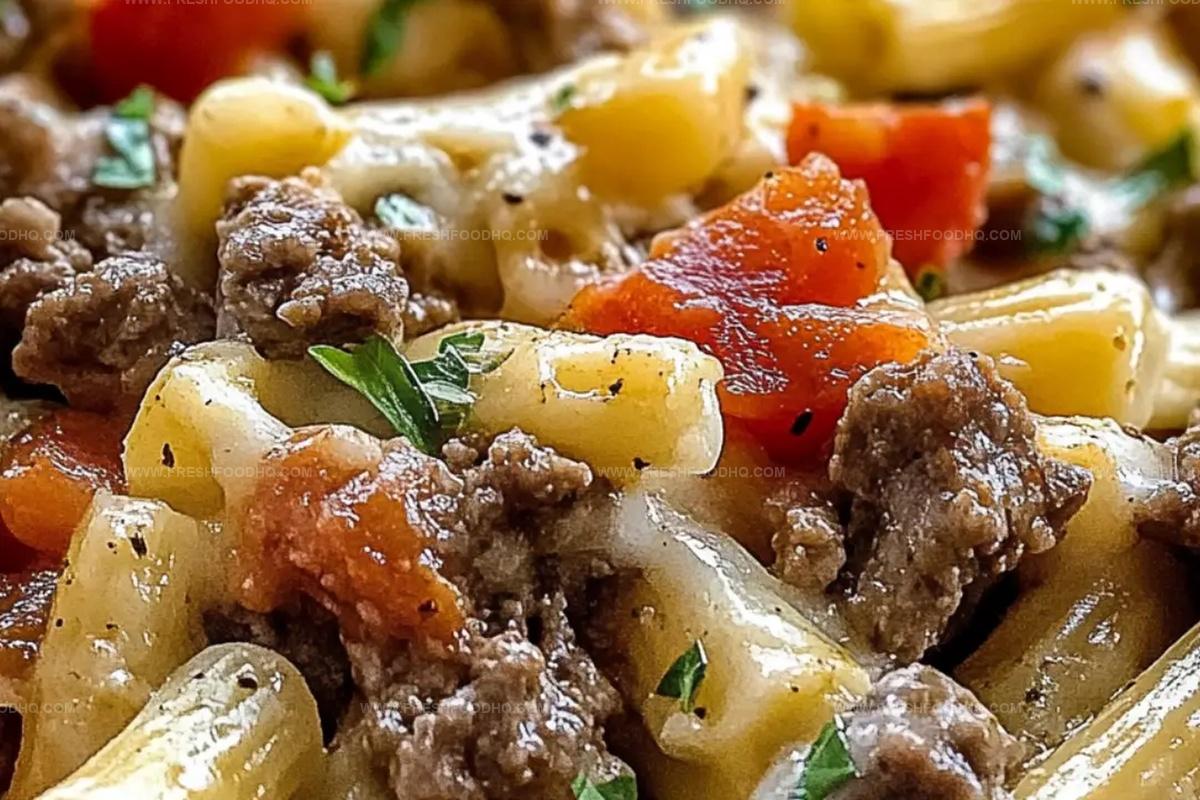
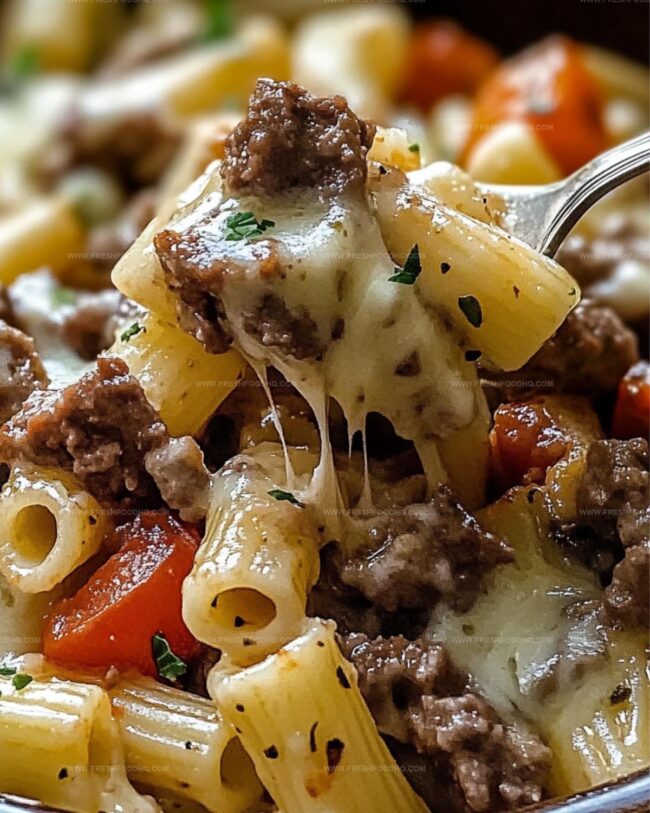
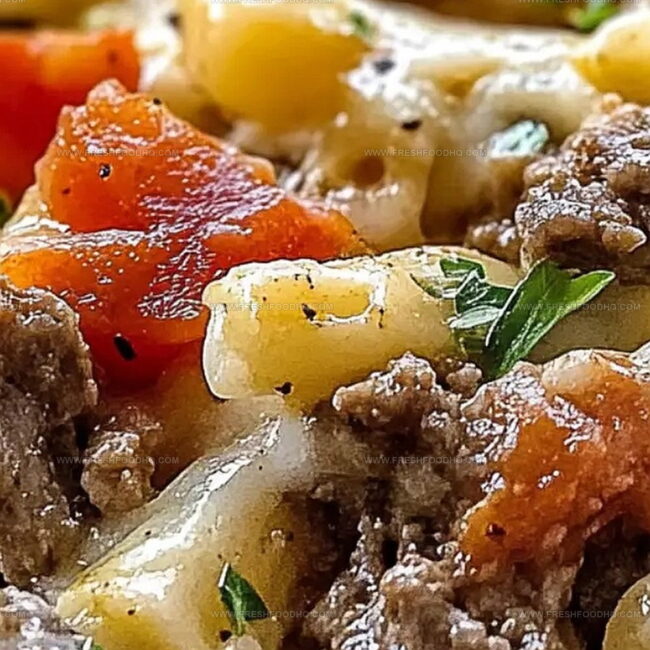
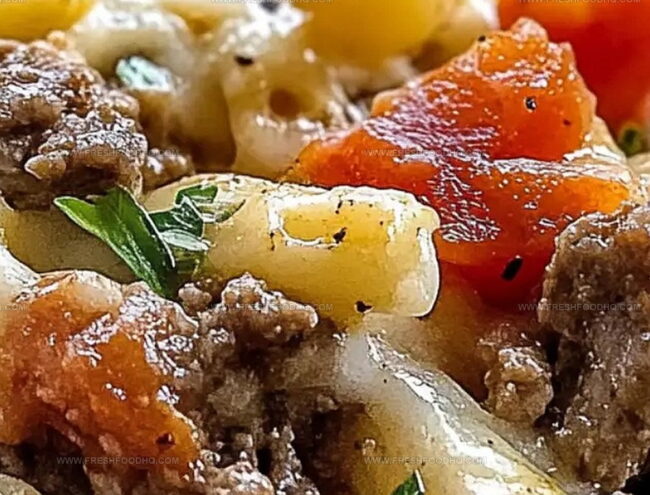
Ethan Caldwell
Founder & Culinary Innovator
Expertise
Farm-to-table cooking, Seasonal recipe creation, Culinary storytelling, Food photography and styling
Education
The Chef’s Academy (Indianapolis, IN)
Ethan didn’t just fall in love with food, he grew into it, surrounded by fields, farmers’ markets, and family meals that told a story.
After sharpening his skills at The Chef’s Academy, he took his passion straight into the farm-to-table movement, working side-by-side with local growers and seasonal flavors.
He believes every recipe should feel like a walk through a summer market: colorful, fresh, and full of possibility.
Outside the kitchen, Ethan’s idea of a perfect day is hiking mountain trails, digging into heirloom vegetables, and hosting casual dinners where seconds are always encouraged.